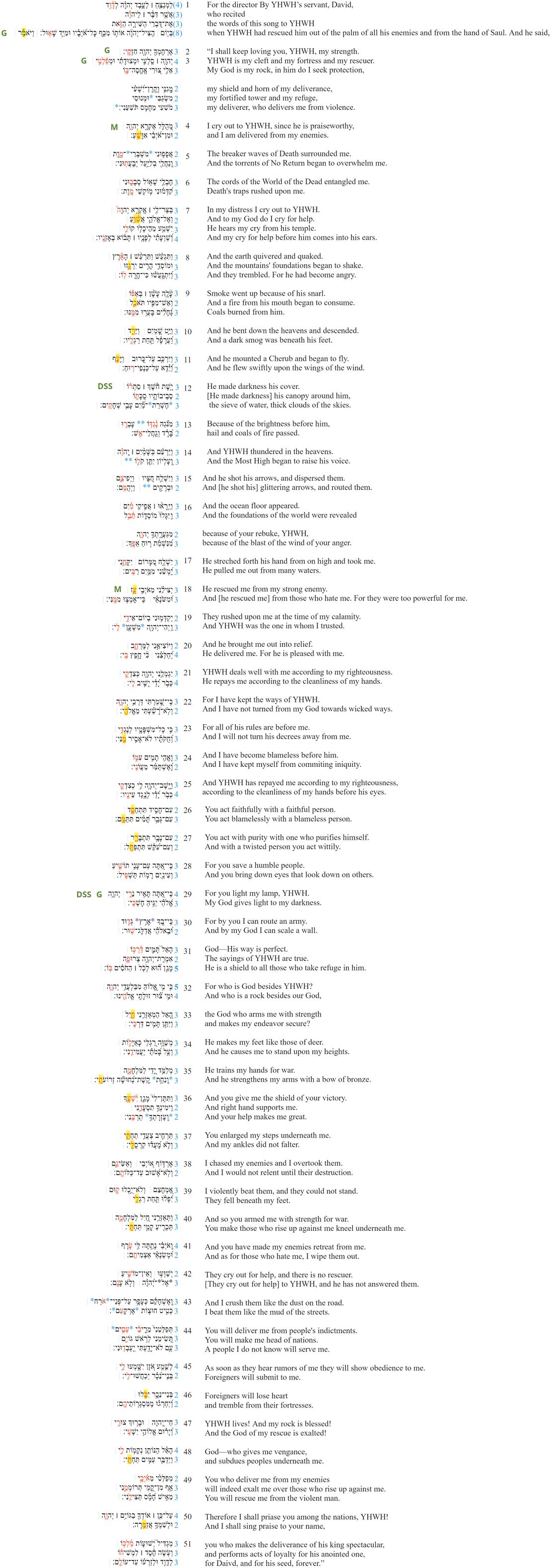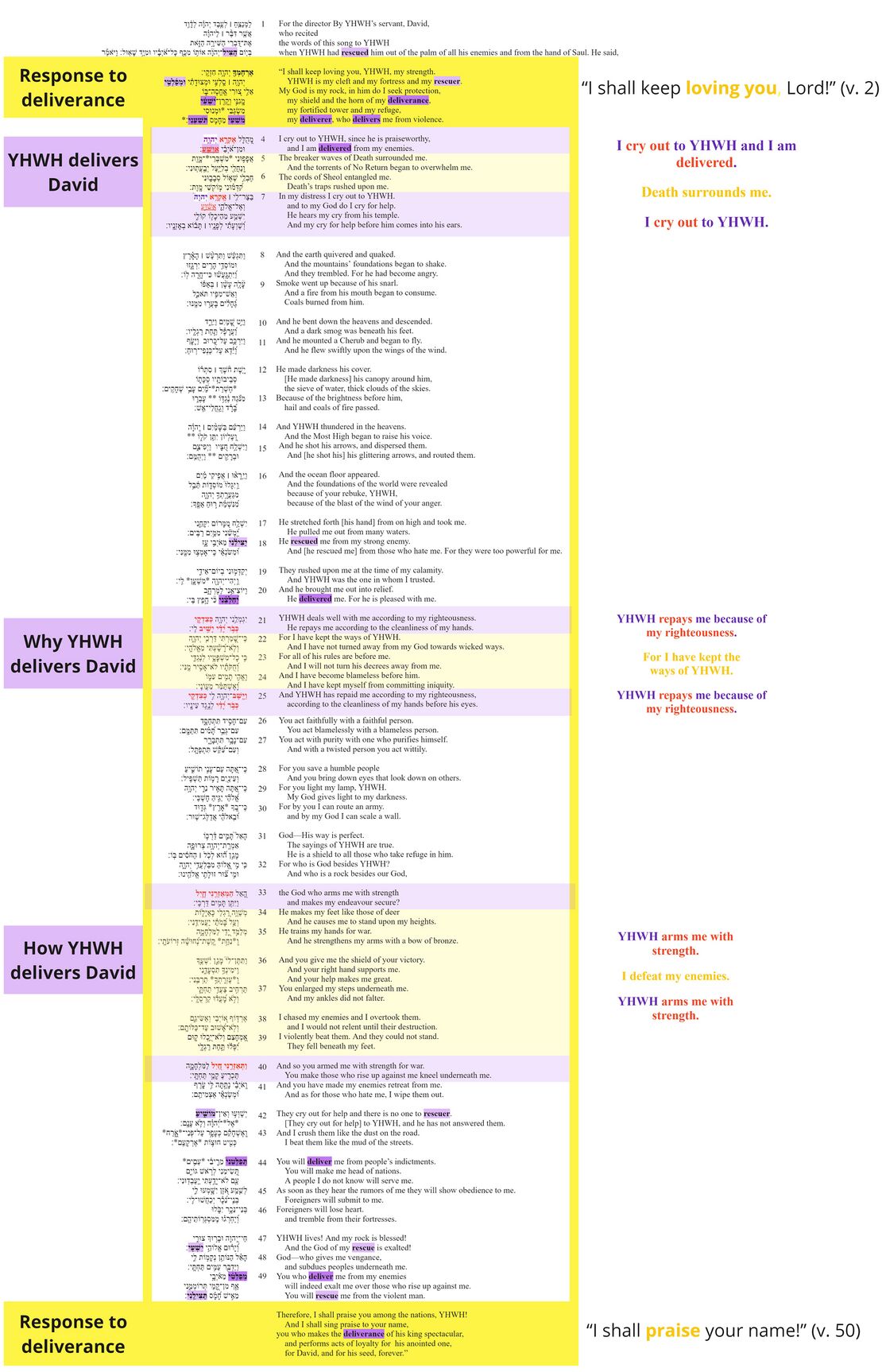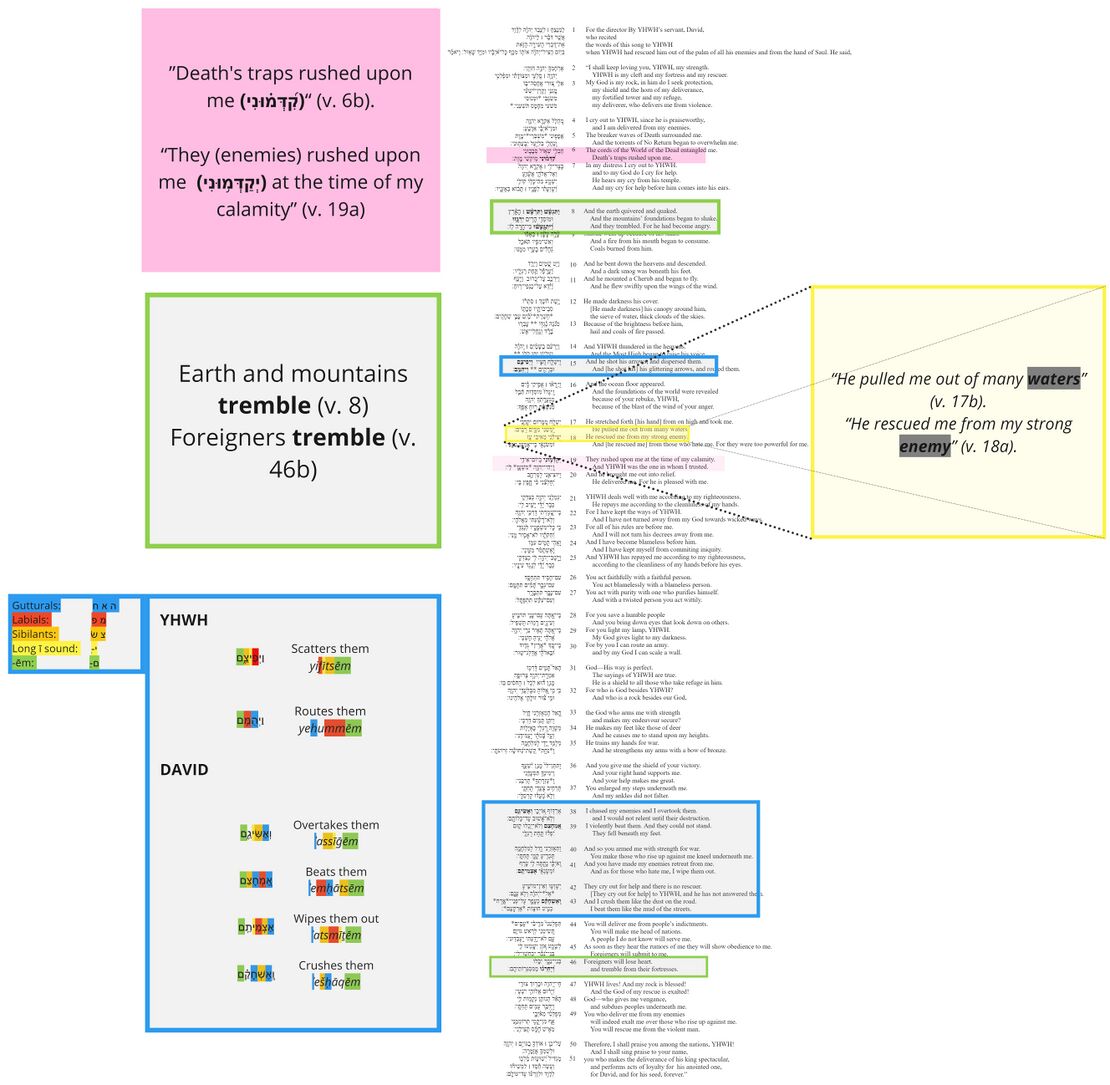Psalm 18 Poetry
About the Poetics Layer
Exploring the Psalms as poetry is crucial for understanding and experiencing the psalms and thus for faithfully translating them into another language. This layer is comprised of two main parts: Poetic Structure and Poetic Features.
Poetic Structure
In poetic structure, we analyse the structure of the psalm beginning at the most basic level of the structure: the line (also known as the “colon” or “hemistich”). Then, based on the perception of patterned similarities (and on the assumption that the whole psalm is structured hierarchically), we argue for the grouping of lines into verses, verses into strophes, strophes into stanzas, etc. Because patterned similarities might be of various kinds (syntactic, semantic, pragmatic, sonic) the analysis of poetic structure draws on all of the previous layers (especially the Discourse layer).
Poetic Features
Bibliography
- Baethgen, Friedrich. 1904. Die Psalmen. Göttingen: Vandenhoeck und Ruprecht. https://archive.org/details/diepsalmen00baet.
- Baillet, Maurice. 1962. “8Q2. Psautier.” In Les “petites grottes” de Qumrân, 148–49, plate XXXI. DJD 3. Oxford: Clarendon Press.
- Barthélemy, Dominique. 2005. Critique Textuelle de l’Ancien Testament: Tome 4. Psaumes. Vol. 4. Göttingen: Vandenhoeck & Ruprecht.
- Bekins, Peter. Forthcoming. “Definiteness” in The Oxford Grammar of Biblical Hebrew.
- Briggs, Charles A. and Emilie Grace Briggs. 1906–1907. A Critical and Exegetical Commentary on the Book of Psalms. New York: C. Scribner's Sons.
- Brooke, Aland England, and Norman McLean, eds. 1906. The Old Testament in Greek.Volume II The Later Historical Books Part I. I and II Samuel. Vol. I,1. London: Cambridge University Press. http://archive.org/details/OldTestamentGreeklxxTextCodexVaticanus.
- Carbajosa, Ignacio. 2020. “10.3.4 Peshitta”, in: Textual History of the Bible, General Editor Armin Lange. Consulted online on 14 April 2021
- Charlesworth, James et. al. 2000. Miscellaneous Texts from the Judaean Desert. DJD XXXVIII. Oxford: Claredon Press.
- Chazon, Esther et. al. 1999. Qumran Cave 4 XX: Poetical and Liturgical Texts, Part 2. DJD XXIX. Oxford: Claredon Press.
- Clines, Davd J.A. 1989. Job 1–20. Word Biblical Commentary vol. 17. Dallas: Word.
- Cohen, Chaim. 1995. “The Basic Meaning of the Term ערפל ‘Darkness.’” Hebrew Studies 36 (1): 7–12.
- Comrie, Bernard. 1985. Tense. Cambridge Textbooks in Linguistics. Cambridge: Cambridge University Press. https://doi.org/10.1017/CBO9781139165815.
- Cowe, S. Peter. First published online: 2020. “3–5.2.5.3 1–2 Samuel (1–2 Reigns)”, in: Textual History of the Bible, General Editor Armin Lange. Consulted online on 15 September 2022.
- Craigie, Peter C. 2004. Psalm 1–50. 2nd edition. Word Biblical Commentary vol. 19. Nashville, TN: Nelson Reference & Electronic.
- Crenshaw, James L. 1972. “We Dōrēk ’al-Bāmŏtê ’Āreṣ.” The Catholic Biblical Quarterly 34 (1): 39–53.
- Croft, William. 2022. Morphosyntax: Constructions of the World’s Languages. Cambridge: Cambridge University Press.
- Cross, Frank Moore. 1975. Studies in Ancient Yahwistic Poetry. Missoula, Montana: Scholars Press for the Society of Biblical Literature. http://archive.org/details/studiesinancient0000cros.
- Cross, Frank Moore et. al. 2005. Qumran Cave 4 XII 1–2 Samuel. DJD XVII. Oxford: The Claredon Press.
- Cross, Frank Moore, and David Noel Freedman. 1953. “A Royal Song of Thanksgiving: II Samuel 22 = Psalm 18.” Journal of Biblical Literature 72 (1): 15–34. https://doi.org/10.2307/3261627.
- Fabry, Heinz-Josef. 2003. “צַר (1),” ed. G. Johannes Botterweck and Helmer Ringgren, trans. Douglas W. Stott, Theological Dictionary of the Old Testament. Grand Rapids, MI; Cambridge, U.K.: William B. Eerdmans Publishing Company.
- Fassberg, Stephen. 2020. “כלום יש מ"ם אנקליטית בלשון המקרא?” In סוגיות בלשון המקרא, edited by Michael Rijke, 87–104. Jerusalem: Academy of the Hebrew Language.
- Fernández Marcos, Natalio. 2013. “The Antiochene Edition in the Text History of the Greek Bible.” In Der Antiochenische Text Der Septuaginta in Seiner Bezeugung Und Seiner Bedeutung, edited by Siegfried Kreuzer and Marcus Sigismund, 57–73. De Septuaginta Investigationes. Göttingen: Vandenhoeck & Ruprecht. https://doi.org/10.13109/9783666536083.57.F
- Fernández Marcos, Natalio, and José Ramón Busto Saiz. 1989. El texto antioqueno de la Biblia Griega. 1: 1-2 Samuel. Textos y estudios Cardenal Cisneros de la Biblia Políglota Matritense 50. Madrid: Inst. de Filología.
- Gray, Alison Ruth. 2014. In Psalm 18 in Words and Pictures. Leiden: Brill. https://brill.com/display/title/23722.
- Greenfield, Jonas C. 1958. “Lexicographical Notes I.” Hebrew Union College Annual 29:203–28.
- Gordis, Robert. 1971. The Biblical Text in the Making: A Study of the Kethib-Qere. Brooklyn: Ktav Publishing House.
- Hardy, H.H. 2022. The Development of Biblical Hebrew Prepositions. Atlanta, GA: SBL Press.
- Haspelmath, Martin. 2007. “Further Remarks on Reciprocal Constructions.” In Reciprocal Constructions, edited by Vladimir P. Nedjalkov, 2087–2115. Amsterdam: John Benjamins Publishing Company.
- Holmstedt, Robert D. 2016. The Relative Clause in Biblical Hebrew. Winona Lake, Indiana: Eisenbrauns. https://doi.org/10.1515/9781575064208.
- Holmstedt, Robert D. 2020. “Parenthesis in Biblical Hebrew as Noncoordinative Nonsubordination.” Brill’s Journal of Afroasiatic Languages and Linguistics 12 (1): 99–118. https://doi.org/10.1163/18776930-01201003.
- Hope, Edward R. 2003. All Creatures Great and Small: Living Things in the Bible. New York: United Bible Societies.
- Huddleston, Rodney D., and Geoffrey K. Pullum. 2002. The Cambridge Grammar of the English Language. Cambridge: Cambridge University Press. http://archive.org/details/cambridgegrammar0000hudd.
- Huehnergard, John, and Aren M. Wilson-Wright. 2014. “A Compound Etymology for Biblical Hebrew Zûlātî ‘Except.’” Hebrew Studies 55. https://www.academia.edu/9939183/2014_A_Compound_Etymology_for_Biblical_Hebrew_z%C3%BBl%C4%81t%C3%AE_except_.
- Hupfeld, Hermann. 1855. Die Psalmen. Vol. 1. Gotha: Friedrich Andreas Perthes.
- Jenni, Ernst. 1992. Die Hebräischen Präpositionen Band 1: Die Präposition Beth. Stuttgart: Verlag W. Kohlhammer.
- Jenni, Ernst. 2000. Die Hebräischen Präpositionen Band 3: Die Präposition Lamed. Stuttgart: Verlag W. Kohlhammer.
- Kauhanen, Tuuka, and Pessoa da Silva Pinto. 2020. “Recognizing Kaige-Readings in Samuel-Kings.” Journal of Septuagint and Cognate Studies 53:67–86.
- Keel, Othmar. 1997. The Symbolism of the Biblical World: Ancient Near Eastern Iconography and the Book of Psalms. Winona Lake: Eisenbrauns.
- Keil, Carl Friedrich and Franz Delitzsch. 1996. Commentary on the Old Testament. Volume 5. Peabody, MA: Hendrickson.
- Khan, Geoffrey. Forthcoming. “Yiqṭol” in The Oxford Grammar of Biblical Hebrew.
- Kruger, Paul A. 2015. “Emotions in the Hebrew Bible: A Few Observations on Prospects and Challenges.” Old Testament Essays 28 (2): 395–420. https://doi.org/10.17159/2312-3621/2015/V28N2A10.
- Kutscher, Edward Yechezkel. 1974. The Language and Linguistic Background of the Isaiah Scroll (I Q Isa[Superscript a]). Studies on the Texts of the Desert of Judah, v. 6. Leiden: Brill.
- Kogan, Leonid. 2015. Genealogical Classification of Semitic: The Lexical Isoglosses. Berlin: De Gruyter. https://doi.org/10.1515/9781614515494.
- Martínez, Florentino García; Tigchellar, Eibert J.C. and Van der Woude, Adam S. 1998. Qumran Cave 11 II: 11Q2–18, 11Q20–31. DJD 23. Oxford, Claredon Press.
- May, Herbert G. 1955. “Some Cosmic Connotations of Mayim Rabbîm, ‘Many Waters.’” Journal of Biblical Literature 74 (1): 9–21. https://doi.org/10.2307/3261949.
- McCarter, P. Kyle. 1973. “The River Ordeal in Israelite Literature.” Harvard Theological Review 66 (4): 403–12. https://doi.org/10.1017/S0017816000018101.
- McCarter Jr., P. Kyle. 1984. 1 Samuel: A New Translation with Introduction and Commentary. Vol. 8. The Anchor Bible. Garden City, NY: Doubleday & Company.
- McCarter Jr., P. Kyle. 1984. 1 Samuel: A New Translation with Introduction and Commentary. Vol. 8. The Anchor Bible. Garden City, NY: Doubleday & Company.
- Miller, Cynthia L. 2003. “A Linguistic Approach to Ellipsis in Biblical Poetry: (Or, What to Do When Exegesis of What Is There Depends on What Isn’t).” Bulletin for Biblical Research 13 (2): 251–70.
- Morrison, Craig E. 2020. “3–5.1.4 Peshitta”, in: Textual History of the Bible, General Editor Armin Lange. Leiden: Brill.
- Noegel, Scott. 2017. “On the Wings of the Winds: Towards an Understanding of Winged Mischwesen in the Ancient Near East.” KASKAL 14:15–54.
- Notarius, Tania. 2017. “Playing with Words and Identity: Reconsidering לָרִב בָּאֵשׁ, אֲנָךְ, and קֵץ/קַיִץ in Amos’ Visions.” Vetus Testamentum 67 (1): 59–86. https://doi.org/10.1163/15685330-12341264.
- Pinker, Aron. 2005. “On the Meaning of השוחנ תשק.” Journal of Hebrew Scriptures 5.
- Rahlfs, Alfred. 1931. Psalmi Cum Odis. Göttingen: Vandenhoeck & Ruprecht. http://archive.org/details/PsalmiCumOdis.
- Reinhart, Tanya. 1984. “Principles of gestalt perception in the temporal organization of narrative texts.” Linguistics 22.779-809.
- Robar, Elizabeth. 2014. The Verb and the Paragraph in Biblical Hebrew: A Cognitive-Linguistic Approach. Leiden: Brill.
- Sanders, Paul. 2000. “Ancient Colon Delimitations: 2 Samuel 22 and Psalm 18.” In Delimitation Criticism: A New Tool in Biblical Scholarship, edited by Marjo Korpel and Josef Oesch, 277–311. Leiden: Brill
- Sperling, S. David. 2017. Ve-Eileh Divrei David: Essays in Semitics, Hebrew Bible and History of Biblical Scholarship. Leiden: Brill. https://brill.com/display/title/25209.
- Stec, David. 2020. “10.3.3 Targum”, in: Textual History of the Bible, General Editor Armin Lange. Consulted online on 14 April 2021
- Sutcliffe, E. F. 1953. “The Clouds as Water-Carriers in Hebrew Thought.” Vetus Testamentum 3 (1): 99–103. https://doi.org/10.2307/1516291.
- Ulrich, Eugene Charles. 1978. The Qumran Text of Samuel and Josephus. Leiden: Brill. https://brill.com/display/title/39176.
- Walton, John. H. 2009. Zondervan Illustrated Bible Backgrounds Commentary (Old Testament): The Minor Prophets, Job, Psalms, Proverbs, Ecclesiastes, Song of Songs. Grand Rapids, MI: Zondervan.
- Wevers, J.W. 1995. Notes on the Greek Text of Deuteronomy. SCS 39. Atlanta, GA: Scholars Press.
- Wilson, Daniel. 2021. “הָיָה in Biblical Hebrew.” In Semitic Languages and Cultures, edited by Aaron D. Hornkohl and Geoffrey Khan, 1st ed., 7:455–72. Cambridge, UK: Open Book Publishers. https://doi.org/10.11647/OBP.0250.16.
- Young, Theron. 2005. “Psalm 18 and 2 Samuel 22: Two Versions of the Same Song.” In Seeking Out the Wisdom of the Ancients: Essays Offered to Honor Michael V. Fox on the Occasion of His Sixty-Fifth Birthday, edited by Ronald L. Troxel, Kelvin G. Friebel, and Dennis R. Magary, 53–70. University Park, Pennsylvania: Penn State University Press. https://doi.org/10.1515/9781575065625-007.






